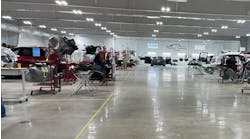Repairability takes center stage at SMDI’s Great Designs in Steel
Every stakeholder in automotive design and production recognizes vehicles are safer, longer-lasting and more affordable to own when repairers have all of the information they need to perform complete, high-quality repairs. This is why the Steel Market Development Institute (SMDI) and its North American steel industry investor companies work closely with OEMs and the repair industry to help design repairability into vehicles.
Automakers and repairers are aware of the central role steel plays in automotive design and occupant protection. But as steel has evolved through the introduction and use of advanced high-strength steels (AHSS) and new ultra high-strength steels (UHSS), it has become more imperative for engineers designing new vehicles and the repairers who will someday need to get them back on the road to learn more about working with those new steels.
One centerpiece for this education is SMDI’s annual “Great Designs in Steel,” the most respected forum for engineers on the subject of automotive steels. No other event in the world brings together the automotive and steel industries in one place like Great Designs in Steel and SMDI recognizes there’s a critical connection between design and repairability. This is why SMDI wanted to ensure steel-related repairability was strongly represented at the 2018 event, inviting I-CAR’s Director of Industry Technical Relations, Jason Bartanen, to speak. In addition, during the same time period, SMDI held a related repairability summit between key stakeholders at its Detroit-area headquarters focusing on welding applications and repairability considerations.
Repairability isn’t just about the design and engineering of a vehicle; it also depends on how the information is provided to repairers. Bartanen’s presentation to an audience of OEM and supplier engineers and designers expanded on a presentation from 2017 which detailed how to identify materials, guidelines for repairability, standardization and continuation of repair information types and improved alignment/standardization of attachment methods for collision repairers. In 2018, Bartanen continued the discussion, focusing on the ways automakers could help improve the information flow to repairers on steel-related issues, which he noted would increase repair quality, improve customer experience and lower the consumer’s total cost of ownership.
In addition to consumer satisfaction and total cost of ownership it is important to recognize repairability has a significant environmental sustainability factor as well. Repairing a vehicle and keeping it on the road spreads the environmental impact of its manufacture – and disposal/recycling – over a longer productive lifespan improving any analysis of its lifecycle cost. This is another factor in which steel provides unexpected environmental benefits over competing, harder-to-repair automotive materials.
But with automakers increasingly turning to new AHSS and UHSS steels, repairability is dependent on the repairer having a clear understanding of what steels are used where in a vehicle, as well as clear direction from the OEM on how and where to perform operations such as sectioning, welding or other attachment methods, bonding, corrosion preparation and more.
This information also plays an important role in assisting insurers in making repair decisions, helping them understand what can or cannot be done cost-effectively in repairs which involve working with high-strength steels.
Bartanen is involved in I-CAR’s critical role of getting imperative information from automakers into the repair and auto insurance industries, and it was the flow of information he worked to expand with his presentation at Great Designs in Steel.
First and foremost, he mentioned repairers need clear and simple automaker guidance on what steels they are using for which applications in a vehicle.
He noted while it’s not necessarily a bad idea for OEMs to provide detailed information on steel grades, repairers generally only need broad classifications such as “mild, AHSS or UHSS” to make most repair decisions. “As a collision repair professional, if I know there’s ultra high-strength steel in that door aperture, I know that I’m going to have to replace it because I’m not going to be able to straighten it,” he explained.
In addition to identifying steels, Bartanen noted, repairers need clear information on what they can and cannot do to steel to preserve the OEM’s original design capabilities. Specifically, he shared a common concern among repairers with the assembled OEM representatives and asked not just for advice, but for clear and simple guidance on decision points which remove the potential for misunderstanding or incorrect repair decisions. Using Honda’s repair guidelines for its 1,500 MPa steel applications in the Accord which forbid straightening and require squeeze-type resistance spot welding at factory joints as an example, Bartanen showed where clear guidance on how to work with specific steel applications improves repairability. He contrasted with other automakers’ documentation showcasing much less-defined guidance, such as saying welding primers were “recommended where applicable.”
“Using words like ‘NEVER’ and ‘MUST’ really helps us,” Bartanen explained. “Saying things like ‘SHOULD’ or ‘RECOMMENDED,’ that’s where we start getting into those gray areas, and that’s where we get into some conflict within the repair industry about what can and cannot be done.”
He also asked OEMs to provide details on potential repair methods in areas where there is significant UHSS usage, sharing examples of how General Motors provides outer body panel sectioning details for replacement of the Chevrolet Malibu B-pillar, or Ford does with detailed sectioning instructions for the F-150 front frame components. Even if such detailed instructions aren’t available, he noted, simple recommendations such as hot/cold straighten and welding method for each individual steel provides real value to the repairer community and contributes to repair quality and consumer satisfaction.
Bartanen’s presentation and the broader discussion around repairability design and information transfer was well-received by the automaker representatives and is an excellent example of the kind of partnership which continues to provide real benefits to everyone involved. We’re proud at SMDI to have played a role in bringing together key repairer, engineer and steelmaker stakeholders to better understand each other’s needs and how best to work together to achieve them. We know those relationships will continue to improve safety, affordability and customer satisfaction, which is what we’re here to accomplish.



